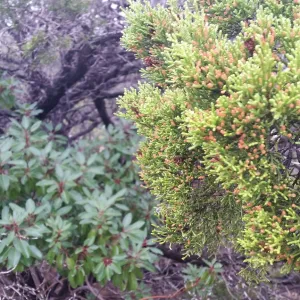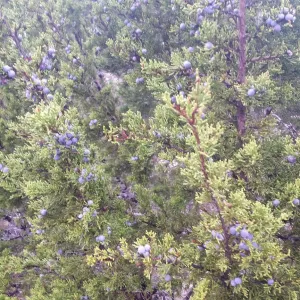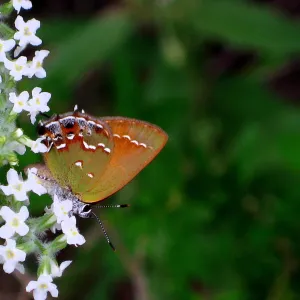By Jane McAuliffe and Mary Dunn – Boerne Chapter, Native Plant Society of Texas
Published in Boerne Star on January 25, 2015
There are at least 50 species of junipers in the Northern Hemisphere, but the type we have here in the Hill Country is Ashe Juniper, or Juniperus ashei. Ashe Junipers are coniferous shrubs or trees of the cypress family Cupressaceae. Although they are often called Post Cedar and Mountain Cedar, they are not cedars. There are many wonderful qualities about Ashe Juniper in spite of the fact that some people suffer from “cedar fever,” a winter allergy that coincides with its pollen production. Ashe Juniper has ecological benefits, is ornamental and can be used in foods.


According to Jan Wrede, a naturalist and local author, it is the dominant evergreen shrub or small tree in the Hill Country and it forms cedar brakes on limestone hillsides. It is considered by the Wasowski’s (Native Texas Plants) to be the most important tree in the Edwards Plateau. “Not only is it absolutely drought tolerant and evergreen, but it also creates organic matter, provide shade, and captures moisture for the seedlings of more delicate flowering trees such as the Texas smoke tree, Texas madrone, Rusty blackhaw viburnum, Mexican redbud, Mexican buckeye, scarlet buckeye, and yellow buckeye.” It has scale-like leaves clustered into branches at the end of round twigs that don’t lose as much water through transpiration as the leaves of oaks and other trees. It is dioecious, meaning there are both female and male trees with the female producing blue, berry-like cones while males produce the pollen that causes allergies.
There is historical evidence that native groups used the wood and bark as fuel and for tool making and today the heartwood of Ashe Juniper is used for fenceposts, crossties, poles, small woodenware and fuel. It is probable that the Ashe Juniper’s small fruits that are blue, soft, pulpy and taste resinous when ripe were eaten while its leaves were used for medicine and ritual. However there is a lack of evidence to pinpoint that it was the Ashe Juniper and not other types of juniper used by Native Americans. It is likely that they used the Redberry juniper (Juniperus pinchotii) or the One-seeded juniper (Juniperus monosperma) as food since both have fruit that is soft, pulpy, sweet and tasty. Ashe Juniper fruit has a distinctly resinous flavor. One person described its taste as what pine would taste like if eaten.

Ecosystem
In its natural surroundings Ashe Juniper provides many benefits. It is the larval host and nectar source for the juniper hairstreak butterfly (Callophrys gryneus). Furthermore, the bark of the Ashe Juniper is necessary to the endangered and rare Golden-cheeked warbler (Setophaga chrysoparia). That bird must have old growth juniper with peeling bark strips since this bark is what it uses to build its nest. This warbler is indigenous to the Edwards Plateau which is its only breeding area. It migrates to winter in Central America returning in early spring. Moreover, this shrub or tree provides nesting sites and habitat for many of our Hill Country birds and other wildlife.
Food
Nineteen species of birds including robins, cedar waxwings, cardinals, and mockingbirds eat the fruit. Not only birds, but many mammals also benefit from the fruit. The scat of raccoons, ring tail cats, gray fox, coyote, and even white-tailed deer has shown that the berries provide food for them. Both birds and animals spread the seeds of the Ashe Juniper. Some authorities feel that passing through the digestive system makes the seeds more viable, but in any case, their digestive tracts do not damage the seeds.
Recently we were introduced by Delmar Cain, a frequent contributor to this column, to orange-cranberry juniper jelly that can be used like cranberry sauce. The following recipe can be adapted according to your preferences:
Orange-cranberry juniper jelly
1 ½ cups sweet vermouth or lillet
½ cup orange liqueur
2 cups sugar (may use Splenda)
2 Tablespoons of juniper berries (tied in cheesecloth)
2-12 ounce bags of fresh or frozen cranberries
Put vermouth, orange liqueur, sugar and juniper berries in a heavy saucepan and bring to a boil over medium heat. Add cranberries and return to a boil. Reduce heat and simmer on low until all the cranberries burst and are soft (at least 10 minutes). Discard the cheesecloth bag. Place in a mold or bowl and cover to refrigerate so it will become firm. If you prefer, you may place the juniper berries as they are into the pot, but be aware that they have seeds that will need to be removed by straining the mixture before eating.
The Ashe Juniper growing in the Hill Country has many uses. Its wood is naturally rot resistant and fence posts of this tree have been known to last 50 years. At one time most old growth juniper was cut for telegraph poles and railroad ties. While other types of junipers are used for medicinal purposes, the Ashe Juniper is not known to have any healing effects.
Although Ashe Juniper is native to central Texas, it is considered an invasive weed by many landowners and developers. It is true that young, shallow rooted, multi-trunked and dense Ashe Juniper invades grasslands that have been fire suppressed and overgrazed. But, old-growth Ashe Junipers are different in that they have true trunks, use less water, are slow growing, less foliated and have very deep roots. Without considering how wholesale removal will affect the balance and stability of the areas where it grows, many simply remove Ashe Juniper. There is research at Texas A&M University (Wilcox) and the Texas Agricultural Extension (Owens) that is examining how deeper roots may actually help with the deep drainage of water into the aquifer.
There is considerable controversy about the value of Ashe Juniper as an ornamental or ecologically valuable tree, especially as it relates to water. According to John Kight, a local conservationist affiliated with the Cibolo Nature Center and activist for water conservation, many people remove Ashe Juniper without considering the possibility that the remaining trees might be lost to such conditions as oak wilt and drought. It is especially important to carefully consider the Ashe Juniper that is growing on steep slopes since removing it will lead to erosion. Mr. Kight recommends “mosaic” clearing where thinning is done a little at a time, allowing grasses and other plants to establish roots that will stabilize the soil and prevent erosion.
In the book, Hill Country Landowner’s Guide by Jim Stanley, there is a paraphrase of Mark Twain’s rhyme that provides us with a way to think about Ashe Juniper.
It ain’t the things we don’t know
That pains us so
But the things we know
That just ain’t so!
